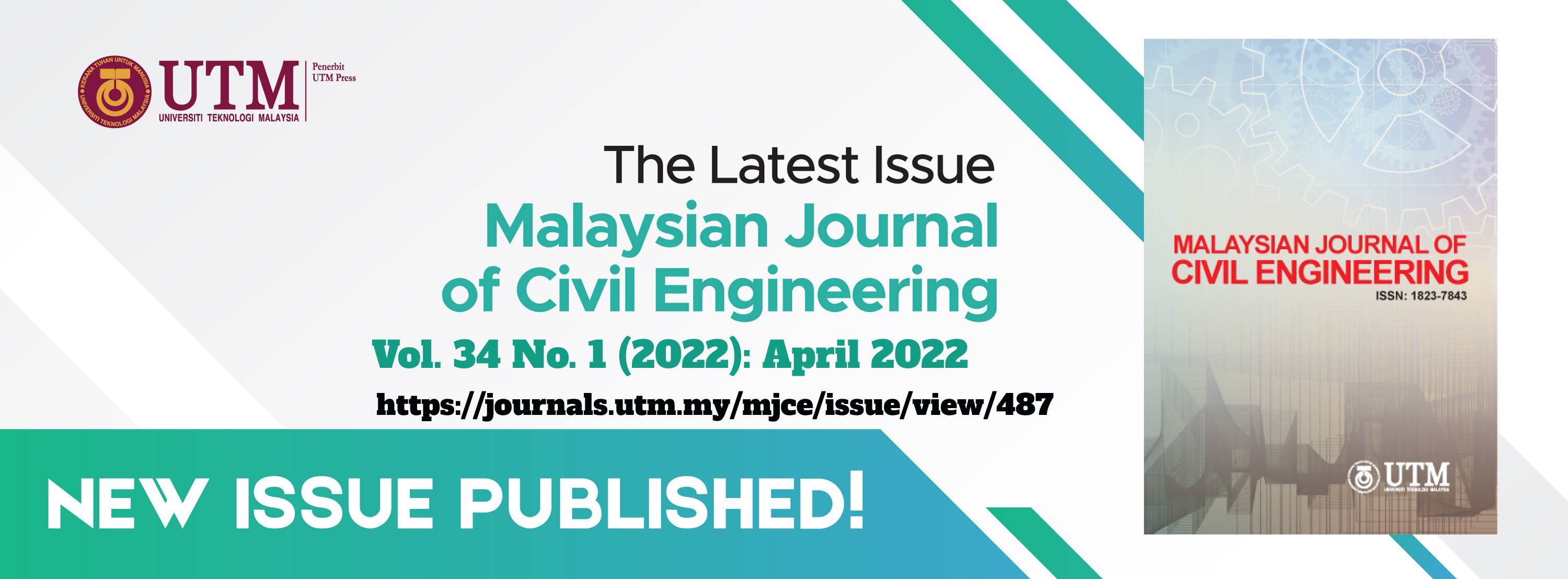EVALUATION OF 3RS CONCEPT FOR SUSTAINABLE STEEL WASTE DISPOSAL: CONTROL STRATEGY
DOI:
https://doi.org/10.11113/mjce.v34.17545Keywords:
Construction industry, Disposal techniques, Steel waste, Sustainable, Control strategyAbstract
The construction industry is consuming substantial quantities of raw materials in processes, and it harms the environment by producing a considerable amount of waste. Steel is one of the common wastes produced in the construction industry. This research paper analyzes steel waste disposal techniques in the construction sites in Malaysia concerning environmental perspectives and sustains steel waste efficiently. This paper aims to examine the practical disposal techniques of steel waste in construction sites using the 3Rs concept of material sustainability. A questionnaire survey was effectively distributed to evaluate the practical disposal techniques of steel waste in the construction sector. The quantitative data of 66 out of 165 respondents were analyzed using SPSS software to decide whether the results met our research objectives. The results prove that construction and demolition stages have the highest amounts percentages of steel waste. Therefore, the reuse technique is a first and preferable option for construction stakeholders rather than adopting recycling techniques which include specific processes rising CO2 emissions. Reduce strategy: The highest impact and the top of the waste disposal hierarchy become a third option. This technique refers to the preliminary stages and stakeholders’ awareness of establishing steel waste management plans. Generally, the authors concluded that conventional implementation of project activities and poor adoption of innovation except for major projects had a significant impact on construction waste and steel waste. Therefore, they suggested studying the incurred cost of adopting each technique.
References
Akhtar, A., & Sarmah, A. K. 2018. Construction and demolition waste generation and properties of recycled aggregate concrete: A global perspective. Journal of Cleaner Production, 186: 262–281. https://doi.org/10.1016/j.jclepro.2018.03.085
Akib, E., & Ghafar, M. N. A. 2015. The validity and reliability of assessment for learning (AfL). Education Journal, 4(2): 64–68.
Alsamarraie, M. M., & Ghazali, F. 2021. The Impact of COVID-19 and Control Strategies Adoptionin the Construction Sector. 25(6): 19524–19531.
Begum, R. A., Siwar, C., Pereira, J. J., & Jaafar, A. H. 2007. Implementation of waste management and minimization in the construction industry of Malaysia. Resources, Conservation and Recycling, 51(1): 190–202. https://doi.org/10.1016/j.resconrec.2006.09.004
Cohen, L., Manion, L., & Morrison, K. 2002. Research methods in education. Routledge.
Di Maria, F., & Micale, C. 2014. A holistic life cycle analysis of waste management scenarios at increasing source segregation intensity: The case of an Italian urban area. Waste Management, 34(11): 2382–2392. https://doi.org/10.1016/j.wasman.2014.06.007
DOTE. 1995. Making waste work: a strategy for sustainable waste management in England and Wales. HMSO London.
Gliem, J. a, & Gliem, R. R. 2003. Calculating, Interpreting, and Reporting Cronbach’s Alpha Reliability Coefficient for Likert-type Scales. 2003 Midwest Research to Practice Conference in Adult, Continuing, and Community Education, 1992: 82–88. https://doi.org/10.1109/PROC.1975.9792
Hassan, H. 2014. Best Available Techniques Guidance Document on. Best Available Techniques Guidance Document on Waste Incinerator.
Hatem, Z. M., Alsamarraie, M. M., & Flaih, A. Y. 2021. Barriers to the Adoption of Industrialized Building System in Iraqi Construction Industry. https://doi.org/http://dx.doi.org/10.21271/ZJPAS.33.3.4
Hu, Y. 2011. Minimization management of construction waste. ISWREP 2011 - Proceedings of 2011 International Symposium on Water Resource and Environmental Protection, 4: 2769–2772. https://doi.org/10.1109/ISWREP.2011.5893453
Jaishankar, M., Tseten, T., Anbalagan, N., Mathew, B. B., & Beeregowda, K. N. 2014. Toxicity, mechanism and health effects of some heavy metals. Interdisciplinary Toxicology, 7(2): 60–72. https://doi.org/10.2478/intox-2014-0009
Jianxin, Y., & Bingjiang, L. I. U. 2002. Life cycle inventory of steel products in China. Acta Scientiae Circumstantiae (in Chinese), 22(4): 519–522.
Kamaruddin, M. A., Aziz, H. A., Alrozi, R., & Jaafar, M. H. 2017. Exploring municipal solid waste and landfill management: A systematic approach. In Landfills: Environmental Impacts, Assessment and Management 151–192.
Mertz, W. 1981. The essential trace elements. Science, 213(4514): 1332–1338. https://doi.org/10.1126/science.7022654
Muhaidin, N. H. M., & Chan, H. B. 2018. The comparison of construction waste produced by conventional method against IBS: A case study in Pulau Pinang. AIP Conference Proceedings, 2020(October 2018). https://doi.org/10.1063/1.5062681
Poon, C.-S., Yu, A. T. W., & Jaillon, L. 2004. Reducing building waste at construction sites in Hong Kong. Construction Management and Economics, 22(5): 461–470.
Saat, S. A. 2013. Solid waste management in Malaysia and ecological modernization theory perspective. Journal of Sustainability Science and Management, 8(2): 268–275.
Sadi, M. A. K., & Abdullah. 2012. Reduce , Reuse , Recycle and Recovery in Sustainable Construction Waste Management. 449: 937–944. https://doi.org/10.4028/www.scientific.net/AMR.446-449.937
Schütte, K. H. 2015. Wireless tri-axial trunk accelerometry detects deviations in dynamic center of mass motion due to running-induced fatigue. PLoS ONE, 10(10): e0141957. https://doi.org/10.1371/journal.pone.0141957
Taira, K. 2020. Two-dimensional temperature distribution in a fixed bed at high spatial resolution visualized by in-situ measurement of iron-ore sintering during combustion. Fuel, 272: 117735.
UNEP-IETC, H. 1996. International source book on environmentally sound technologies for municipal solid waste management, United Nations Environment Programme (UNEP). International Environmental Technology Centre (IETC).
Vongdala, N. 2018. Heavy Metal Accumulation in Water, Soil, and Plants of Municipal Solid Waste Landfill in Vientiane, Laos. International Journal of Environmental Research and Public Health, 16(1), 22. https://doi.org/10.3390/ijerph16010022
Wypych, G. 2013. 17 - RECYCLING (G. B. T.-H. of M. W. (Fifth E. Wypych (ed.); 719–729. Elsevier. https://doi.org/https://doi.org/10.1016/B978-1-895198-62-1.50020-2
Yahya, K., & Boussabaine. 2016. Using life cycle assessment for estimating environmental impacts and eco-costs from the metal waste in the construction industry. Management of Environmental Quality: An International Journal, 27(2): 227–244. https://doi.org/10.1108/MEQ-09-2014-0137
Yahya, K., & Boussabaine, H. 2010. Quantifying environmental impacts and eco-costs from brick waste. Architectural Engineering and Design Management, 6(3): 189–206. https://doi.org/10.3763/aedm.2009.0106
















